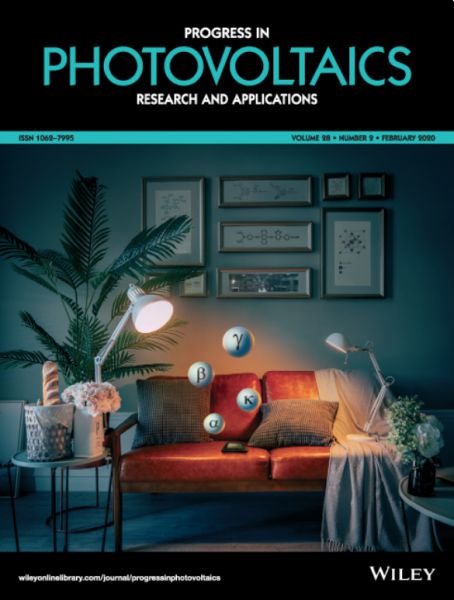設施農業:智慧感測【化學系/葉鎮宇特聘教授】
| 論文篇名 | 英文:Thermal and angular dependence of next‐generation photovoltaics under indoor lighting 中文:在室內照明下,新生代光伏電池的熱與角度相依性 |
| 期刊名稱 | Progress in Photovoltaics: Research and Applications. |
| 發表年份,卷數,起迄頁數 | 2020, 28: 111–121 |
| 作者 | Chia‐Yuan Chen*, Ting‐Yang Kuo, Chien‐Wu Huang, Zih‐Hong Jian, Po‐Tsung Hsiao, Chin‐Li Wang, Jian‐Ci Lin, Chien‐Yu Chen, Chao‐Hsuan Chen, Yung‐Liang Tung, Ming‐Chi Tsai, Kuan‐Min Huang, Chih‐Ming Chen, Cheng‐Wei Hsu, Yen‐Chiao Chen, Zingway Pei, Yogesh S. Tingare, Hsien‐Hsin Chou, Chen‐Yu Yeh*(葉鎮宇), Ching‐Yao Lin*, Yuh‐Lang Lee*, Hao‐Wu Lin*, Hsin‐Fei Meng*, Pi‐Tai Chou*, Chun‐Guey Wu* |
| DOI | 10.1002/pip.3211 |
| 中文摘要 | 染料敏化太陽能電池,有機薄膜光伏電池和鈣鈦礦太陽能電池等新生代光伏技術有望有效地收集環境光能。因此對其光伏特性的更多更深入的了解對於在室內光線照明下創建新應用至關重要。本研究首次系統地研究了緊湊型熒光燈和發光二極管光下大面積器件的溫度係數和光伏參數的角度相依性。與單晶矽太陽能電池相比,這些新興的光伏器件不僅具有更高的開路電壓(高達約1 V)和更高的功率轉換效率(在9.2%〜22.6%的範圍內),而且溫度更低取決於電壓和輸出功率(<-0.6%°C-1),以及更寬的角度響應(超過75度)。最先進的染料敏化和有機薄膜器件還顯示出有利的正溫度係數電流,後者甚至對填充係數具有正熱相依性。這些特徵表明,對於實際的室內應用而言,新生代光伏設備比傳統的晶體矽太陽能電池更受青睞。 |
| 英文摘要 | Next‐generation photovoltaic technologies such as dye‐sensitized solar cells, organic thin‐film photovoltaics and perovskite solar cells are promising to efficiently harvest ambient light energy. However, more and deeper understanding of their photovoltaic characteristics is essential to create new applications under room light illumination. In this study, for the first time, the difference in temperature coefficients and angular dependence of photovoltaic parameters for the large‐area devices are investigated systematically under the compact fluorescent lamp and light‐emitting diode light. These emerging photovoltaic devices, compared with the single crystalline silicon solar cells, not only have higher open‐circuit voltage (up to approximate 1 V) and bet- ter power conversion efficiency (in the range of 9.2% ~ 22.6%) but also exhibit less temperature dependent voltage and output power (< −0.6% °C −1 ), as well as broader angular response (over 75 degrees). The state‐of‐ the‐art dye‐sensitized and organic thin‐film devices also show advantageously positive temperature coefficients of cur- rent, and the latter even has positive thermal dependence of fill factor. These features Next‐generation photovoltaic technologies such as dye‐sensitized solar cells, organic thin‐film photovoltaics and perovskite solar cells are promising to efficiently harvest ambient light energy. However, more and deeper understanding of their photovoltaic characteristics is essential to create new applications under room light illumination. In this study, for the first time, the difference in temperature coefficients and angular dependence of photovoltaic parameters for the large‐area devices are investigated systematically under the compact fluorescent lamp and light‐emitting diode light. These emerging photovoltaic devices, compared with the single crystalline silicon solar cells, not only have higher open‐circuit voltage (up to approximate 1 V) and better power conversion efficiency (in the range of 9.2% ~ 22.6%) but also exhibit less temperature dependent voltage and output power (< −0.6% °C−1), as well as broader angular response (over 75 degrees). The state‐of‐ the‐art dye‐sensitized and organic thin‐film devices also show advantageously positive temperature coefficients of cur-rent, and the latter even has positive thermal dependence of fill factor. These features suggest the next‐generation photovoltaic devices are more favorable than the conventional crystalline silicon solar cells for real‐life indoor applications. |







